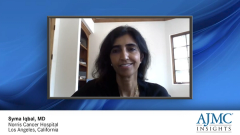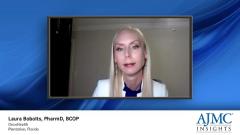
Key Cost Drivers in Treating Gastroesophageal Cancers
Laura Bobolts, PharmD, BCOP, discusses key cost drivers impacting treatments for upper GI and esophageal cancers.
Episodes in this series

Laura Bobolts, PharmD, BCOP: There are 3 main cost drivers I typically think about when describing the rising costs of care for upper GI [gastrointestinal] cancers. The first one is pretty obvious. It’s the new targeted therapies coming to market in that landscape. Any time you add a targeted therapy to chemotherapy, you increase cost. But thankfully we’re seeing that many of these therapies improve survival for our patients with cancer. That cost that is warranted when you have significant benefit for our patients. The landscape evolving with PD-1 inhibitors, nivolumab plus ipilimumab, trastuzumab deruxtecan, and trastuzumab-based therapies is going to be a cost driver.
The second [cost driver] is the rapid FDA approval of these therapies. The FDA has approved 7 new regimens for upper GI cancers since 2021, and 6 of those 7 regimens have included a PD-1 inhibitor. Those are going to increase costs. But also, the landscape is changing very rapidly, so payers need to plan their budgets for the rapid change in new therapies coming to market. Third, the good news is that our patients are living longer. Patients who live longer are going to incur more costs. This will be a cost driver, but this is a cost driver that is well warranted, as the majority of our targeted therapies added to chemotherapy in the first-line setting of gastric, gastroesophageal junction [GEJ], and esophageal cancers improve survival. They’re adding additional months of life to our patients with cancer. That will incur longer treatments and larger costs over time, but this is good news. All our scientific advances are coming to fruition to do good for our patients with cancer.
One of the largest challenges in terms of containing costs when treating patients with upper GI and esophageal cancers is when broad indications get approved by the FDA that may differ slightly from where the therapy may be most beneficial and provide the most value. The easiest example to show is when we have seen certain PD-1 inhibitors get FDA approved in combination with platinum- and fluoropyrimidine-based chemotherapy in the first-line settings of gastric, gastroesophageal junction, and esophageal cancers, irrespective of PD-L1 status.
With the approval of nivolumab in combination with fluoropyrimidine- and platinum-based chemotherapy in patients with adenocarcinoma for esophageal and GEJ cancers, the NCCN [National Comprehensive Cancer Network] requires patients to have a PD-L1–positive status with a CPS [combined positive score] of 5 or more. When you look at pembrolizumab plus chemotherapy, irrespective of histology in esophageal and GEJ cancers, in patients with adenocarcinoma or squamous cell carcinoma, the NCCN requires a PD-L1 CPS of 10 or more. This is challenging in containing costs because in this scenario, the NCCN is aligning a little closer with the patient population that may benefit most from the addition of a PD-1 inhibitor to chemotherapy in these cancers. While the FDA indication is broader, a broader indication is going to expand the patient population, and that can incur larger costs.
Expert oncologists in the field of esophageal cancer and GEJ are more likely to use the PD-1 inhibitors with chemotherapy if the patient is PD-L1 positive in the scenarios I mentioned, where the NCCN is slightly more detailed in their requirement [compared with] the FDA, which is biomarker agnostic. When our oncologists do that, they’re aligning closer to where the evidence may lie in which these targeted therapies can be most beneficial for that PD-L1–positive subset patient population.
Keep in mind the data are always changing in oncology so rapidly, so other oncologists who treat multiple tumor types might not know that if a patient is PD-L1 negative per se and they have esophageal cancer and they want to add pembrolizumab to chemotherapy, that patient is less likely to benefit as well as those who are PD-L1 positive. All in all, the broad FDA indication can expand access, which is a good thing for our patients with cancer. It puts the onus on the treating oncologist to select the patient whom they feel is most appropriate for these therapies, irrespective of PD-L1 status, with the approval being biomarker agnostic. But the NCCN does provide additional guidance in certain areas to oncologists, which is very helpful when the guidance aligns with a patient population that may benefit more.
Early interventions can help promote the slowing of disease progression and hopefully improve the quality of life of our patients with cancer, if we’re being cognizant of looking at the biomarkers unique to that patient with cancer. In gastric cancer, we’re going to look for HER2 positivity, MSI [microsatellite instability], and PD-L1 positivity. In esophageal cancers, we’re going to look in our adenocarcinomas for HER2 positivity. We’re going to also look across the patient population for MSI and PD-L1 positivity.
It’s so important to look for those biomarkers from a payer’s perspective, from that health plan lens, because if we can identify a biomarker that the patient may have, we can match that with precision medicine, a targeted therapy that can add to the patient’s treatment in which it can hopefully extend their survival, add life for the patient to spend more time with their family, and hopefully delay disease progression. Ultimately, we hope that cascades to an improvement in quality of life by getting that patient on precision medicine as soon as possible by drawing those appropriate biomarkers up front. We’re hoping that targeted therapy can then delay the patient from having any challenges down the line by controlling the disease in a timelier manner. All in all, hopefully that can promote the well-being of patients with cancer.
Transcript edited for clarity.
Newsletter
Stay ahead of policy, cost, and value—subscribe to AJMC for expert insights at the intersection of clinical care and health economics.































































